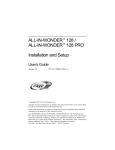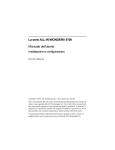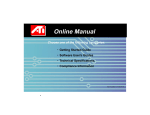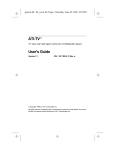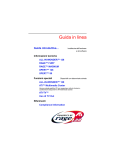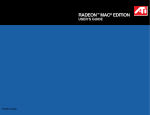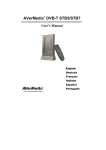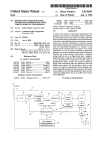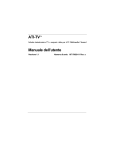Download ATI Technologies All-in-Wonder 128 User`s guide
Transcript
ALL-IN-WONDER™ RADEON™ / ALL-IN-WONDER™ 128 PRO / ALL-IN-WONDER™ 128 Installation and Setup User’s Guide Version 4.0 P/N 137-70090-40 Rev. D © Copyright 2000, by ATI Technologies Inc. All rights reserved, including those to reproduce this guide or parts thereof, in any form without the express written permission of ATI Technologies Inc. Features and specifications are subject to change without notice. Trademarks and/or registered trademarks are the properties of their respective owners: ALL-IN-WONDER 128 ALL-IN-WONDER 128 PRO, RAGE 128, RADEON – ATI Technologies Inc.; AC-3, ProLogic – Dolby Laboratories, Inc.; dbx – dbx Professional Products; Athlon – Advanced Micro Devices. Inc.; Macintosh – Apple Computer Inc.; Direct3D, Windows 98, Windows NT, Windows Millennium Edition, Windows 2000 – Microsoft Corp.; Celeron, Pentium Pro, Pentium II, Pentium III – Intel Corporation; VGA – International Business Machines Corp.; VESA – Video Electronics Standards Association; WaveTop – WavePhore WaveTop Inc. i Disclaimer The manufacturer (MFR) reserves the right to make changes to this document and the products which it describes without notice. The MFR shall not be liable for technical or editorial errors or omissions made herein; nor for incidental or consequential damages resulting from the furnishing, performance, or use of this material. The MFR makes no representation that the interconnection of products in the manner described herein will not infringe on existing or future patent rights, nor do the descriptions contained herein imply the granting of license to make, use or sell equipment constructed in accordance with this description. The PCI accelerators have been designed to support the PCI local bus standards. Some computers use proprietary local bus circuitry and therefore may not be fully compatible with the MFR’s local bus cards. Although tested successfully in a wide variety of computer systems, the MFR cannot be held responsible for any incompatibilities which may occur between this card and the system configuration you plan to use. We recommend that you check with the dealer or distributor for your computer system before installing your card. Product Notices Dolby* Laboratories, Inc. Manufactured under license from Dolby Laboratories. Confidential Unpublished Works. (c) 1992-1997 Dolby Laboratories, Inc. All rights reserved. ii Table of Contents Getting Started............................................................... 5 Using this Guide ............................................................................................ 6 What is the ALL-IN-WONDER Family?...................................................... 7 Digital flat panel support........................................................................ 8 System Requirements .................................................................................... 9 Other Sources of Information ...................................................................... 10 Online Help .......................................................................................... 10 Online manual ...................................................................................... 10 ATI Multimedia Center Guide ............................................................. 10 Installing the Hardware and Software ....................... 11 Installing the Hardware ............................................................................... 12 Multiple monitor support...................................................................... 14 Windows® “New Hardware Found”........................................................... 17 To identify new hardware in Windows® 98 or Me ............................. 17 To identify new hardware using “Add New Hardware Wizard” ......... 18 Installing Enhanced Drivers for Windows® 98 or Windows® Me ............ 19 To install the ATI enhanced drivers for Windows® 98 or Windows® Me ................................................... 20 Installing Enhanced Drivers for Windows® 2000 ...................................... 21 To identify new hardware in Windows® 2000 .................................... 22 To install the ATI enhanced drivers for Windows® 2000 ................... 23 Starting the ATI Multimedia Center ........................................................... 25 Input and Output Adapters .......................................................................... 26 Windows® Volume Control........................................................................ 30 TV reception tips .................................................................................. 31 Using Your ALL-IN-WONDER ..................................... 33 Connecting your PC to a video source ........................................................ 34 Attaching a TV to Your Card ...................................................................... 36 Using SCART connectors for European televisions .............................................................................. 38 Using and adjusting TV Out................................................................. 38 Starting Windows® with television display enabled ........................... 39 Using a monitor vs. using the television display.................................. 39 Adjusting the monitor display .............................................................. 39 Viewing text on television.................................................................... 40 Reducing edge distortion...................................................................... 41 Changing display configurations.......................................................... 42 Using games and applications .............................................................. 42 iii Reference ..................................................................... 43 Troubleshooting........................................................................................... 44 Basic troubleshooting tips .................................................................... 44 Windows® 98 / Windows® ME troubleshooting tips ......................... 45 Audio and Video Troubleshooting .............................................................. 46 Audio problems ... ................................................................................ 46 Video problems ... ............................................................................... 50 CD Audio Connectors ................................................................................. 51 To Remove the ATI Multimedia Center...................................................... 52 Japanese Users Please Note ........................................................................ 52 Compliance Information.............................................................................. 53 Index ............................................................................. 55 iv 5 CHAPTER 1 Getting Started Welcome to the convergence of your PC, TV and video! This new technology changes the way you view TV, graphics, and video on your PC. The ALL-IN-WONDER cards are powerful TV tuners, DVD players, digital VCRs, and 2D & 3D graphics and video accelerators. Their features will take your PC’s graphics and video capabilities to the next level. This guide provides all the information you need to install your ALL-IN-WONDER card. IN THIS CHAPTER... ■ Using this Guide on page 6 ■ What is the ALL-IN-WONDER Family? on page 7 ■ System Requirements on page 9 ■ Other Sources of Information on page 10 6 Getting Started Using this Guide The organization of this guide is as follows: Installing the Hardware and Software on page 11 provides instructions for installing your ALL-IN-WONDER card and software, and connecting video input and output devices to your ALL-IN-WONDER card. Using Your ALL-IN-WONDER on page 33 explains how you can take advantage of the advanced new features of your ALL-IN-WONDER card. Reference on page 43 provides troubleshooting tips and regulatory compliance information for your card. User Guide: The ATI Multimedia Center User’s Guide that came with your card explains how to use the special features that the ATI Multimedia Center provides. Getting Started 7 What is the ALL-IN-WONDER Family? The ALL-IN-WONDER family of cards delivers highperformance 3D and 2D graphics, as well as advanced multimedia features. You can play games, watch TV or videos, listen to audio CDs, explore the Internet, and work in Windows® 98, Windows® Millennium Edition, and Windows® 2000 as never before. ALL-IN-WONDER’s advanced 3D acceleration gives you detailed color graphics and 3D features like multi-texturing, alpha blending, and fog effects. ALL-IN-WONDER also provides powerful 2D graphics features through the Display Properties pages: Settings Customize your desktop settings such as desktop size, screen resolution and color depth, and store various desktop preferences for easy recall later. Adjustment Adjust the position and size of your screen, as well as manipulate the screen refresh rate, frequencies and synchronization. Color Correction Correct color tone differences between real color values and the way your monitor displays them, and store various color correction preferences for easy recall later. For comprehensive online information on the above features, just right-click on your desktop, click Properties, select the tab you want help for, then click the Help button. ATI’s RADEON and RAGE 128 PRO accelerator chips provide advanced 3D support and accelerated 2D graphics. Games and software applications that support the RADEON and RAGE 128 PRO — including Direct3D applications and OpenGL — run with fluid motion and in brilliant color. ALL-IN-WONDER is a part of ATI’s legendary series of graphics accelerators. Your existing 2D games and applications will snap to life with 128-bit acceleration and faster, more vibrant colors. 8 Getting Started You can use your ALL-IN-WONDER card to connect your computer to a television. This feature is ideal for playing games, giving presentations, watching movies, and browsing the Internet. (For more information, see Attaching a TV to Your Card on page 36.) ALL-IN-WONDER also turns your PC into an intelligent TV with the following features: • TV-On-Demand™ • Zoom-in • Scheduled Viewing • Channel Scanning • Video capture • Closed Captioning with “Hot Words” (North America only) • Program transcript recording (North America only) • TV magazine (North America only) • Digital VCR with real-time video compression • Interactive Program Guide • dbx® stereo audio TV (because Europe uses different stereo TV standards, only the 32MB ALL-IN-WONDER 128, the 32MB ALL-IN-WONDER 128 PRO, and ALLIN-WONDER RADEON provide stereo TV audio in Europe.) ALL-IN-WONDER does not provide stereo TV in Japan. Digital flat panel support ALL-IN-WONDER RADEON’s DVI-I (Digital Visual Interface Integrated) option supports digital flat panel displays. See page 16 for more information. A/V IN CATV A/V OUT DVI-TO-VGA VGA CONNECTOR ADAPTER FROM MONITOR Getting Started System Requirements Computer system ALL-IN-WONDER 128, ALL-IN-WONDER 128 PRO (Pentium MMX, minimum) Pentium® II, Pentium® III, Celeron™, or compatible systems with PCI Local Bus or AGP bus slot. ALL-IN-WONDER RADEON Pentium® II, Pentium® III, AMD K6/Athlon, or compatible with AGP 2X or AGP 4X bus slot. Expansion Slot PCI cards use a PCI slot; AGP cards use an AGP slot. Operating System ALL-IN-WONDER 128, ALL-IN-WONDER 128 PRO, ALL-IN-WONDER RADEON Windows® 98, Windows® Me, Windows® 2000. Monitor VGA, supporting minimum 640x480 resolution. A Plug-and-Play monitor that supports VESA’s Display Channel specifications (DDC1 or DDC2b) is required to take advantage of the DDC1/DDC2b features. The DVI-I interface on ALL-IN-WONDER RADEON can be used to attach a DVI display or an analog VGA monitor, using the supplied DVI-I-to-VGA adapter. 9 10 Getting Started Other Sources of Information If you need additional help or require information that is not included in this guide, see the following sources: Online Help If you require additional information, you can refer to the online help available under Windows® 98, Windows® Millennium Edition, or Windows® 2000 for more information about using ATI’s enhanced drivers. For information on your card’s graphics features, double-click the ATI icon in the lower-right corner of your screen. Online manual Your ALL-IN-WONDER card comes with localized online manuals that describe the extensive features of your card. To open the online manual 1 Insert the ATI INSTALLATION CD-ROM into your CD-ROM drive. If Windows runs the ATI INSTALLATION CD-ROM automatically, proceed to step 5. 2 In the Windows® taskbar, click Start. 3 Click Run.... 4 Type the following: D:\ATISETUP (or substitute your CD-ROM drive letter.) 5 Click the Online Manual icon. ATI Multimedia Center Guide The ATI Multimedia Center User’s Guide that came with your card explains how to use the special features that the ATI Multimedia Center provides. 11 CHAPTER 2 Installing the Hardware and Software Installing your card consists of three, easy steps. • Placing the card in your computer • Installing ATI’s enhanced display drivers • Attaching input and output cables and optional TV, VCR, camcorder, etc. This chapter explains how to place the card in your computer, how to install the software, and how to connect the input and output cables. IN THIS CHAPTER... ■ Installing the Hardware on page 12 ■ Installing Enhanced Drivers for Windows® 98 or Windows® Me on page 19 ■ Installing Enhanced Drivers for Windows® 2000 on page 21 ■ Starting the ATI Multimedia Center on page 25 ■ Input and Output Adapters on page 26 ■ Windows® Volume Control on page 30 12 Installing the Hardware and Software Turn off the power to your system, and discharge your body’s static electric charge by touching a grounded surface — for example, the metal surface of the power supply — before performing any hardware procedure. The manufacturer assumes no liability for any damage, caused directly or indirectly, by improper installation of any components by unauthorized service personnel. If you do not feel comfortable performing the installation, consult a qualified computer technician. Damage to system components, the accelerator card, and injury to yourself may result if power is applied during installation. Note Before you install your ALL-IN-WONDER card, we recommend that you first uninstall the driver for your current video card, and reconfigure your operating system to use the standard display driver (VGA) supplied with your operating system. For more information about changing to the VGA driver, see your operating system documentation. Installing the Hardware Now that you have prepared your computer, you are ready to install your card. If you are not sure whether your card is PCI or AGP (ALL-IN-WONDER RADEON is AGP-only), compare the bottom edge of your card with the following illustration: PCI AGP 2x Universal AGP 2x/4x Installing the Hardware and Software To install your card 1 Power-off the computer and monitor, then disconnect the monitor cable from the back of your computer. VIDEO OUTPUT CONNECTOR MONITOR CABLE 2 Remember to discharge your body’s static electricity by touching the metal surface of the computer chassis. Remove the computer cover. If necessary, consult your computer system manual about removing the cover. POWER SUPPLY 13 14 Installing the Hardware and Software 3 If the old graphics card sticks, rock it gently from end to end. If you intend to run multiple monitors (see Multiple monitor support on page 14), proceed to step 4. Otherwise, remove any existing graphics card from your computer. SCREW Remember to save the screw. OLD GRAPHICS CARD Or, if your computer has any on-board graphics capability, you may need to disable it on the motherboard. For more information, see your computer documentation. Multiple monitor support If you use multiple monitors, the ALL-IN-WONDER must be the primary graphics card. Normally, the system BIOS determines whether the AGP or PCI card will be the primary. For PCI cards, the system normally assigns priority to the card slots in order of their appearance. Please refer to your computer system manual for more information. Installing the Hardware and Software 4 Grasp the new card by the top edge and carefully seat it firmly into the correct slot (PCI or AGP). Ensure that the metal contacts are completely pushed into the slot. 15 If necessary, remove the metal cover from the empty expansion slot that you select (PCI cards use a PCI slot; AGP cards use the AGP slot), then align your new card with an empty expansion slot, and press it in firmly until fully seated. ALL-IN-WONDER PCI EXPANSION SLOT AGP EXPANSION SLOT Note: AGP 4x/2x cards can be used in either AGP 4x or AGP 2x slots. 5 Replace the screw to fasten the card in place, and replace the computer cover. SCREW ATI 3D GRAPHICS CARD 16 Installing the Hardware and Software 6 Plug the monitor cable into your card (if you are running multiple monitors, connect their cables to the appropriate connectors), then turn on the computer and monitor(s). If your ALL-IN-WONDER RADEON card has a DVI-I connector, you can connect a flat panel to it, as shown below. To connect a VGA monitor to the DVI-I connector, plug the supplied DVI-I-to-VGA adapter into the DVI-I connector, then plug your monitor cable into the adapter. Make sure your monitor cable is securely fastened. TO VGA MONITOR DISPLAY CABLE TO FLAT PANEL DISPLAY (DVI-READY CARDS ONLY) DVI-I CONNECTOR ON CARD VGA CONNECTOR FROM MONITOR DVI-I-TO-VGA ADAPTER You are now ready to proceed with the installation of ATI’s enhanced drivers. For detailed instructions, select your operating system from the list below: • Windows® 98/Millennium Edition, see Windows® “New Hardware Found” on page 17. • Windows® 2000, see page 21. Installing the Hardware and Software 17 Windows® “New Hardware Found” If you are running Windows® 98 or Millennium Edition (Me), new hardware may be detected after you restart your computer. Follow the step-by-step instructions below to allow Windows® to correctly identify your new hardware. To identify new hardware in Windows® 98 or Me 1 Windows® 98/Me briefly displays the “New Hardware Found” dialog before launching the “Update Device Driver Wizard”. If the wizard does not appear, proceed directly to Installing Enhanced Drivers for Windows® 98 or Windows® Me on page 19. 2 Click Next. 3 Click Finish. 4 Insert your Windows® 98/Me CD-ROM into your CD-ROM drive. 5 Click OK. 6 Type the following: Windows® 98 D:\WIN98 Windows® Me D:\WINME (If D is not your CD-ROM drive, substitute D with the correct drive letter.) 7 Click OK. 8 Click Yes to restart your computer. You are now ready to install your ATI enhanced drivers. Proceed to Installing Enhanced Drivers for Windows® 98 or Windows® Me on page 19, and follow the step-by-step instructions to complete the installation. After restarting your system, Windows® 98/Me will briefly display the “New Hardware Found” dialog. Depending on your new hardware, you will either be prompted to insert your Windows® 98/Me CD-ROM, or Windows® 98/Me will launch the “Add New Hardware Wizard”. 18 Installing the Hardware and Software If Windows® 98/Me automatically begins installing drivers for your new hardware, click Yes to restart your computer when prompted; then proceed to Installing Enhanced Drivers for Windows® 98 or Windows® Me on page 19. To identify new hardware using “Add New Hardware Wizard” 1 Windows® 98/Me launches the “Add New Hardware Wizard”, which prompts you to search for the Standard PCI Graphics Adapter (VGA). 2 3 4 5 6 Click Next to continue. Select Search for the best driver for your device. Click Next to continue. Click Next to start the driver search. Click Next to install the Standard PCI Graphics Adapter (VGA). 7 Click Finish. 8 Click Yes to restart your computer. You are now ready to install your ATI enhanced drivers. Proceed to Installing Enhanced Drivers for Windows® 98 or Windows® Me on page 19, and follow the step-by-step instructions to complete the installation. Installing the Hardware and Software 19 Installing Enhanced Drivers for Windows® 98 or Windows® Me With Windows® 98 or Me running on your computer, you need to install the enhanced ATI drivers to take advantage of your card’s higher performance, resolutions, and special features. To ensure that you install the latest drivers, install the ATI enhanced drivers located on the CD-ROM shipped with your graphics accelerator card. • • Close all open applications before installing your ATI software. Before installing the ATI enhanced drivers, ensure that any previously-installed ATI display drivers have been removed from your system. To do this: 1. In My Computer, double-click Control Panel, then double-click Add/Remove Programs. 2. Click ATI Display Driver, then click Add/Remove. Notes • • Always use the latest version of the ATI Installation CD-ROM to install ATI display drivers and multimedia software. The last three digits of the CD part number represent the version — a higher number indicates a later version. All ATI Installation CD-ROMs include a complete set of display drivers and multimedia software. 20 Installing the Hardware and Software To install the ATI enhanced drivers for Windows® 98 or Windows® Me 1 Insert the ATI INSTALLATION CD-ROM into your CD-ROM drive. If Windows® runs the CD-ROM automatically, proceed to step 6. 2 Click Start. 3 Select Run. 4 Type the following: D:\ATISETUP (If D is not your CD-ROM drive, substitute D with the correct drive letter.) 5 6 7 8 9 Click OK. Click ATI Easy Install to begin the Installation Wizard. Click Next. Click Yes to accept the license agreement. Follow the Wizard’s on-screen instructions to complete the installation. The Express installation option is recommended. If your ATI product includes a multimedia component, the software for that component will automatically be installed, along with the ATI enhanced drivers, by selecting this option. The Custom installation option can be used to specify which components are installed, or the location in which the software is installed. Installing the Hardware and Software 21 Installing Enhanced Drivers for Windows® 2000 With Windows® 2000 running on your computer, you need to install the enhanced ATI drivers to take advantage of your card’s higher performance, resolutions, and special features. To ensure that you install the latest drivers, install the ATI enhanced drivers located on the CD-ROM shipped with your graphics accelerator card. • • • You need administrator privileges to install drivers in Windows® 2000; refer to your system documentation. Close all open applications before installing your ATI software. Before installing the ATI enhanced drivers, ensure that any previously-installed ATI display drivers have been removed from your system. To do this: 1. In My Computer, double-click Control Panel, then double-click Add/Remove Programs. 2. Click ATI Display Driver, then click Add/Remove. Notes • • Always use the latest version of the ATI Installation CD-ROM to install ATI display drivers and multimedia software. The last three digits of the CD part number represent the version — a higher number indicates a later version. All ATI Installation CD-ROMs include a complete set of display drivers and multimedia software. 22 Installing the Hardware and Software To identify new hardware in Windows® 2000 After restarting your system, Windows® 2000 briefly displays the “New Hardware Found” dialog. Depending upon your new hardware, Windows® 2000 either automatically installs its own bundled drivers, or it launches the “Add New Hardware Wizard”. If Windows® 2000 automatically installs drivers for your new hardware, proceed to To install the ATI enhanced drivers for Windows® 2000 on page 23. If Windows® 2000 does not have a driver available, when the “Found New Hardware Wizard” window appears, click CANCEL, and proceed to To install the ATI enhanced drivers for Windows® 2000 on page 23. Installing the Hardware and Software 23 To install the ATI enhanced drivers for Windows® 2000 1 Insert the ATI INSTALLATION CD-ROM into your CD-ROM drive. If Windows® runs the CD-ROM automatically, proceed to Step 6. 2 Click Start. 3 Click Run. 4 Type the following: D:\ATISETUP (If D is not your CD-ROM drive, substitute D with the correct drive letter.) 5 Click OK. 6 Click ATI Easy Install to start the Installation Wizard. 7 Follow the Wizard’s on-screen instructions to complete the installation. 8 When the Setup Complete screen appears, click Yes to restart your computer, remove the ATI INSTALLATION CD-ROM, then click Finish. The first time you restart your computer, more drivers will automatically be installed. For correct resolution and refresh rate operation, you need to select a display device. You should also change the color palette from 256 colors (the default) to a higher number of colors. ATI recommends at least “High Color (16-bit)” for best performance with its multimedia applications. Note Your ALL-IN-WONDER card must be the primary display (see Multiple monitor support on page 14) for correct operation of TV and video functions. 24 Installing the Hardware and Software To increase the number of colors 1 Right-click on a clear area of your desktop, then click Properties. 2 Click Settings. If you are using multiple monitors, click the monitor icon whose color depth you want to change. If you click a secondary monitor and Extend my Windows desktop onto this monitor is not checked, you cannot change that monitor’s settings. Each monitor has its own color settings. 3 In the Colors box, select High Color (16 bit), True Color (24 bit) or True Color (32 bit). Your type of monitor and video adapter determine the maximum number of colors. The RAGE 128 and RADEON display drivers on your ATI Installation CD-ROM are the latest and fastest available, but at ATI, we are constantly improving our products, so check the ATI web site at www.ati.com for newer software. 1 Click North America or Europe. 2 Click Drivers / Updates, then click Retail Generic Supported. Drivers downloaded from the ATI website: • Double-click the self-extracting executable file to start the installation. Note Windows will automatically reboot your system after the drivers are installed. Installing the Hardware and Software 25 Starting the ATI Multimedia Center From LaunchPad. The LaunchPad provides a convenient way to start all your Multimedia Center features—just click the one you want. LaunchPad opens automatically when you start your computer, or if you prefer, you can right-click LaunchPad, and uncheck Load on Startup in the drop-down menu to disable this feature. From Windows® taskbar. 1 2 3 4 In the Windows taskbar, click Start. Point at Programs . Point at ATI Multimedia Center . Click TV, DVD, Video CD, CD Audio, or File Player. Note The first time you launch TV, you must complete the Initialization Wizard. After that, the Wizard will not run unless you want to re-run it. The Initialization Wizard guides you through setting up TV channels, Parental Control, Sound, and TV-on-Demand. For information on the ATI Multimedia Center, see the online help. 26 Installing the Hardware and Software Input and Output Adapters Your ALL-IN-WONDER uses input and output adapters that let you connect audio and video devices to the card. You can use these adapters to: • Connect a VCR, laserdisc player, or camcorder, and watch movies on your PC. • Connect your camcorder and capture video for use in presentations, Web pages, or use third-party videoconferencing software. • Connect your big-screen TV, and share the PC experience with a group of people, or play games on your big-screen TV. • Attach a VCR to the video output and record presentations, games, internet, etc. • Note • To hear sound when you use your ALL-INWONDER card’s TV feature, ensure that your card is connected to the line-in connector of your sound card: see page 29. For information on the CD audio connectors see page 51. CD In CD Out AV In Tuner AV Out DVI/ VGA Out ATI Graphics Chip ALL-IN-WONDER Card Installing the Hardware and Software Notes 27 Please note that the ALL-IN-WONDER cards detect copyprotected input video sources, and will refuse to capture video from such sources. Many VHS tapes and DVD discs are copyprotected, which protects them from being copied onto your computer. DVD audio output The ALL-IN-WONDER cards support Dolby ProLogic™ output for connection to a surround-sound system through the standard stereo output connection from your sound card. Only ALL-IN-WONDER RADEON supports S/PDIF digital audio output at this time. 28 Installing the Hardware and Software To watch movies on your PC or capture video from your VCR, camcorder, or laserdisc player Use the ATI input adapter to connect a VCR, camcorder, or laserdisc player to your ALL-IN-WONDER card, as shown. The audio and video output connectors on your VCR, camcorder, or laserdisc player will be similar to these. Use composite video out or S-video out. S-Video will provide better results. S-VIDEO OUT COMP. VIDEO OUT L. AUDIO OUT R. AUDIO OUT Cables with RCA plugs at each end, available separately from a consumer electronics dealer. Cable with S-Video plug at each end. OR S L R A/V IN CATV ATI INPUT ADAPTER (Enlarged here for clarity) A/V OUT ALL-INWONDER Installing the Hardware and Software 29 To display your PC output on TV and record your PC output on videotape Use the output adapter to connect a TV, camcorder, or VCR to your ALL-IN-WONDER card, as shown. The audio and video input connectors on your TV, camcorder, or VCR will be similar to these. Use COMPOSITE VIDEO IN or S-VIDEO IN. S-Video will provide better results. To use your TV as a display, you COMP. R. AUDIO L. AUDIO S-VIDEO must enable TV Out. See Using VIDEO IN IN IN IN and adjusting TV Out on page 38. OR Cable with S-Video plug at each end. Cable with RCA plug at each end, available separately from a consumer electronics dealer. A/V IN output adapter CATV A/V OUT SOUND CARD To record audio on your stereo VCR or to hear audio through your TV speakers, use a stereo cable with two RCA plugs at one end, and a mini stereo phone plug at the other, available separately from a consumer electronics dealer. ALL-INWONDER LINE OUT LINE IN S/PDIF connection (ALL-IN-WONDER RADEON only) S/PDIF Dolby Digital AC-3 Amplifier Cable with RCA plugs, available from a consumer electronics dealer 30 Installing the Hardware and Software Windows® Volume Control For correct audio performance, your sound card’s line input must be active. To display the Line Input setting in the Windows ® Volume Control panel: 1 Right-click the speaker icon in the Taskbar (usually in the lower-right corner of your screen). 2 Click Open Volume Controls. 3 If the Line-In volume slider is not visible, click Options, then click Properties. 4 Click the Line-In volume control checkbox, then click OK. •If the Mute checkbox is checked, click it to cancel muting. If the speaker icon is not in your Taskbar, do the following: • In the Windows taskbar, click Start, point to Settings, then click Control Panel. • Double-click Multimedia. • In the Audio tab, check Show volume control on Taskbar. To select the sound card connector for TV audio input The sound card connector determines which mixer slider is controlled by the ATI Multimedia Center’s volume slider. 1 Click the Setup button in the TV Player control panel, then click the Display tab. 2 Click the Initialization Wizard button, then click the Next button twice to open the TV Sound Initialization Wizard. 3 Click the audio input that matches the connection between your ATI card and your sound card. If you are not sure how it is connected, click each source (CD Audio, Line-In, etc.), and listen for the sound. Installing the Hardware and Software 31 TV reception tips • In the TV Tuner tab, ensure that you click the correct setting for cable or antenna. • For the best indoor antenna reception, use an amplified model, and move it as far away from your monitor as possible. • If you experience problems with cable input, a signal amplifier may improve reception. 32 Installing the Hardware and Software 33 CHAPTER 3 Using Your ALL-IN-WONDER For comprehensive information on ALL-IN-WONDER’s multimedia features, please see the Using Your ATI Multimedia Center User’s Guide that came with your card. For correct operation of your card’s multimedia features, ALL-IN-WONDER must be your computer’s primary graphics card. For more information, see Multiple monitor support on page 14. . IN THIS CHAPTER... ■ Connecting your PC to a video source on page 34 ■ Attaching a TV to Your Card on page 36 ■ Using SCART connectors for European televisions on page 38 34 Using Your ALL-IN-WONDER Connecting your PC to a video source To connect your computer to a VCR or camcorder, attach a connector cable from the VCR or camcorder to the ATI Input Adapter (see page 35). Most VCRs and camcorders have a Composite video output, also referred to as a phono jack or RCA output. A growing number of VCRs and camcorders have another type of video output called S-Video, which provides a higher quality display than Composite video. To connect a VCR or camcorder to your ALL-IN-WONDER 1 Turn off your computer and your VCR or camcorder. 2 Ensure your graphics card is installed correctly. 3 Determine if your VCR or camcorder has an S-Video or Composite video connection. 4 Looking at the back of your computer, locate your graphics card. Using the ATI Input Adapter, attach one end of the cable to your graphics card and the other to your VCR or camcorder. 5 Turn on your computer and your VCR or camcorder. Using Your ALL-IN-WONDER S-VIDEO OUT Cable with S-Video plug at each end. Note that S-Video does not provide an audio connection; connect left and right audio outputs to the ATI Input Adapter. COMP. VIDEO OUT L. AUDIO OUT R. AUDIO OUT Cables with RCA plugs at each end, available separately from a consumer electronics dealer. OR S L R A/V IN CATV ATI INPUT ADAPTER (Enlarged here for clarity) A/V OUT ALL-INWONDER 35 36 Using Your ALL-IN-WONDER Attaching a TV to Your Card Using your ALL-IN-WONDER’s Composite or S-Video output, you can connect a television set as your computer’s display. You can use your card to do the following: • View computer output directly on your television. Depending upon your television, you can choose NTSC or PAL formats. • Display images on both the TV and VGA monitor simultaneously. • Provide a big-screen experience for entertainment PCs that is ideal for playing games, giving presentations, watching movies, and browsing the Internet. • Record videotapes of your computer’s display. Note DVI digital flat panel and television display cannot be used simultaneously. If you are recording a videotape, you will need a television monitor to view while you record. To connect your graphics card to a television • You must attach a TV before enabling TV output • In order to record audio on your VCR or hear audio through your TV speakers, you must connect the audio cables (see page 29). • If your television has cable input only, which is the case for older units, you can connect your graphics card to your television using your VCR or an RF modulator that accepts audio input. RF modulators are available at most consumer electronics dealers. Connect the ALL-IN-WONDER’s audio output to the RF modulator’s audio input. 1 Turn off your computer and your television. 2 Determine if your television has an S-Video connection or an RCA video-in connection. 3 Looking at the back of your computer, locate your graphics card. 4 Connect the supplied output cable adapter to the A/V OUT connector on the card. Using Your ALL-IN-WONDER 37 5 Using a cable with either S-Video or RCA connectors, attach one end of the cable to the output cable adapter and the other to your television. 6 Turn on your computer and your television. If there is no display, you may need to enable the television output capability; see Using and adjusting TV Out on page 38. For detailed cabling diagrams and audio connections, see Input and Output Adapters on page 26. If you have a television connected to your VCR, you can use the television as your computer’s display. For information about connecting a television to your VCR, see the documentation that came with your VCR. Note If you have a television connected to a VCR that is conected to the ALL-IN-WONDER’s A/V OUT, and you use the television as your computer’s display, copy-protected DVD movies may appear alternately bright and dim. IMPORTANT INFORMATION for European Customers Some PC monitors in Europe cannot be used simultaneously with television display. When you enable television display in Europe, the refresh rate for the monitor and television is set to 50Hz. Some monitors may not support this refresh rate and could be damaged. • Please check the documentation supplied with your monitor to see if your monitor supports a refresh rate of 50Hz. If your monitor does not support 50 Hz (or if you are not sure), then turn off your monitor before turning on your computer when using your television as a display. For information on disabling television display, see To enable and disable the television display on page 38. Some televisions in Europe may use an SCART connection. If you use SCART, please read Using SCART connectors for European televisions on page 38 before attempting to connect your PC to your television. 38 Using Your ALL-IN-WONDER Using SCART connectors for European televisions Audio In (Right = Red) (Left = White) Connect to audio source Connect to TV or VCR Cable 1 Cable 2 SCART Connector Video In (Yellow) Connect to graphics card Using an SCART connector with a Composite cable The SCART connector supports only the Composite video format, which is the most common type. The above illustration shows how to connect to an SCART connector with a Composite cable. If your television supports S-Video input, you should use an S-Video cable (available in most consumer electronics stores) to view your PC on a television. An S-Video connection produces a higher quality display than Composite video. Using and adjusting TV Out To enable and disable the television display 1 Start Windows®. 2 Click Start. 3 Point to Settings, then click Control Panel. 4 Double-click Display. 5 Click the ATI Displays tab. Windows® 98 users click the Advanced… button, then click the ATI Displays tab. 6 Click the green enable/disable button next to the word “TV” to enable/disable television display. 7 Click OK or Apply to save the changes you have made. For information about how to use television display and the ATI Displays Properties page, click the Help button. Using Your ALL-IN-WONDER 39 Starting Windows® with television display enabled The television screen may become scrambled temporarily during the initial Windows® logo display. This is only a temporary effect, and your television screen will be restored within a few seconds. During start up, your TV Out graphics card will go through a sequence of mode settings, during which your television display will remain blank. This process takes only a few seconds and helps program the television display. Using a monitor vs. using the television display Using your television for your computer’s display is ideal for playing games, giving presentations, watching movies, and browsing the Internet. The display on your monitor may change or look squashed. This occurs because the display adjusts to fit the dimensions of your television. To correct the monitor’s display, use the controls on the monitor to adjust the display size and position. Older monitors and large, speciality monitors may not work with television display enabled. If you experience problems when television display is enabled, disable television display to restore your monitor’s display. Adjusting the monitor display The size of the display on your monitor may be smaller and not perfectly centered when you have television display enabled. These effects are caused by the changes required to provide a proper display on the television. Use the controls available on the Adjustments tab on the Monitor Properties page (click the Monitor button on the ATI Displays page) to adjust the display on your monitor only. Click the Television button to adjust the television display only. 40 Using Your ALL-IN-WONDER Viewing text on television Due to the different technology used in the manufacturing of televisions and PC monitors, standard PC text may be unreadable on your television. You can compensate for this by using larger fonts. To use larger display fonts 1 Start Windows®. 2 Click Start. 3 Point to Settings, then click Control Panel. 4 Double-click Display. 5 Click the Settings tab. 6 In the Font Size box, select the size you want your displayed fonts to be. Windows® 98 users click the Advanced… button then select your font size. 7 To customize the size of displayed fonts, select Custom or Other. 8 Click the OK button, then click the Close button. Click the Yes button to restart your computer and use your new settings. Using Your ALL-IN-WONDER 41 Reducing edge distortion When using a television for your PC’s display, you may see some edge distortion on the left and right side of your television screen. This effect depends on your television and the PC application you are running. To reduce edge distortion, you can increase the horizontal size. To increase the horizontal size 1 Start Windows®. 2 Click Start. 3 Point to Settings, then click Control Panel. 4 Double-click Display. 5 Click the ATI Displays tab. Windows® 98 users click the Advanced… button, then click the ATI Displays tab. 6 Click the TV button. 7 Click the Adjustments tab. 8 Click the plus (+) button under Horizontal Screen to increase the horizontal size of the television display. 9 Click OK or Apply to save the changes you have made. You can also reduce edge distortion by reducing the brightness. To change the brightness 1 Start Windows®. 2 Click Start. 3 Point to Settings, then click Control Panel. 4 Double-click Display. 5 Click the ATI Displays tab. Windows® 98 users click the Advanced… button, then click the ATI Displays tab. 6 Click the TV button. 7 Drag the Brightness slider to the left to decrease the brightness. 8 Click OK or Apply to save the changes you have made. 42 Using Your ALL-IN-WONDER Changing display configurations If you move your computer to a place where you are using television display only, make sure that you have the television display feature enabled first; see To enable and disable the television display on page 38. Using games and applications Some older games and applications may program the graphics card directly to run under a specific display mode. This may cause your television display to turn off automatically or become scrambled (the PC monitor will not be affected). Your television display will be restored once you exit the game or if you restart your system. 43 CHAPTER 4 Reference This chapter contains troubleshooting tips for your ALL-IN-WONDER card. IN THIS CHAPTER... ■ Troubleshooting on page 44 ■ CD Audio Connectors on page 51 ■ To Remove the ATI Multimedia Center on page 52 ■ Compliance Information on page 53 44 Reference Troubleshooting The following troubleshooting tips may help you if you experience problems. Contact your dealer for more advanced troubleshooting information. Basic troubleshooting tips • Check that the card is seated properly in its expansion slot. If the problem still exists, try a different PCI expansion slot. • Ensure that the monitor cable is securely fastened to the card. • Make sure that the monitor and computer are plugged in and receiving power. • If necessary, disable any built-in graphics capabilities on your mother board. For more information, consult your computer’s manual or manufacturer. (Note: some manufacturers do not allow the built-in graphics to be disabled or to become the secondary display.) • Make sure that you selected the appropriate monitor when you installed your enhanced driver. • If you use an indoor antenna, you will get the best results with an amplified model. Place it as far away from the PC monitor as possible, to avoid interference. • Splitting the cable or antenna input can reduce the signal quality. For the best reception, connect the cable or antenna directly to your card. • Make sure that your audio card’s line input is active (see Windows® Volume Control on page 30). Reference 45 Windows® 98 / Windows® ME troubleshooting tips For Windows® 98 / Windows® ME troubleshooting tips, rightclick the ATI icon in the taskbar, and select Troubleshooting. If you have problems during start-up, start your computer in Safe Mode. To load Windows® 98 / Windows® ME in Safe Mode 1 Turn on your computer. 2 In Windows® 98, or Windows® ME, press and hold the CTRL key until the Windows Startup Menu appears, then select the number for Safe Mode, and press Enter (on some computers, you can press F8 instead of CTRL to display the Windows® Startup Menu). In Safe Mode, open the Device Manager and check for duplicate display adapter and monitor entries if you are using only one graphics card. • Disable any programs that start automatically when you start Windows® 98 / Windows® ME. • Check that you have the correct monitor and display driver selected in the Display Properties. For more information, click Help in the Start menu. • Check for the existence of memory managers and ensure they are configured properly. • Refer to additional information in the Windows® 98 / Windows® ME README file located in the root directory on the ATI Installation CD-ROM. • For technical assistance, refer to your technical support documentation, or contact your vendor. If you don’t hear audio, make sure that your audio card’s line input is active (see Windows® Volume Control on page 30). 46 Reference Audio and Video Troubleshooting If you have problems with video or audio, try these suggestions. Audio problems ... No sound Check your speakers: • If you have external speakers, ensure that they are poweredon (POWER indicator light is on) and connected to the LINE-OUT or SPEAKER OUT connectors on your sound card. Still no sound? Play a .WAV sound: 1 Click Start, point at Settings then double-click Sounds. 2 In the Events area, Click Asterisk, then click a .WAV file in the Sound area. 3 Click the Play button , select Control Panel, to preview the sound. If you still do not hear any sound, open the Volume Control: • Click Start, point at Programs , point at Accessories , point at Entertainment , then select Volume Control. Or, right-click the speaker icon (usually in the lower-right corner of your screen), then click Open Volume Controls. If the speaker icon is not in your Taskbar, do the following: • In the Windows Taskbar, click Start, point to Settings, then click Control Panel. • Double-click Multimedia. • In the Audio tab, check Show volume control on the Taskbar. • Ensure that the Volume Control and the Wave channel are not muted or set very low. When you hear sound from your speakers, you know they are working. • If you still experience audio problems, check the audio connections to your ALL-IN-WONDER card. Reference No sound from TV Ensure that the audio connection between your ALL-IN-WONDER card and your sound card is correct. • For complete installation instructions, see page 29. A/V IN output adapter CATV A/V OUT SOUND CARD ALL-INWONDER LINE IN 47 48 Reference Can’t capture sound Check the Record mixer settings: 1 Click Start, point at Programs , point at Accessories , point at Entertainment , then select Volume Control. Or, right-click the speaker icon (usually in the lowerright corner of your screen), then click Open Volume Controls. 2 In the Volume Control menu, click Options, click Properties, click Recording, then click OK. The Recording Control opens. 3 Ensure that Line (or the Audio input you selected in the Sound Initialization Wizard) is checked, then click to close the dialog. Can’t capture sound when recording from a videotape. Connect the VCR audio output to your PC: • Left and right audio output from your VCR must be connected to your ALL-IN-WONDER card (note that S-Video does not provide an audio connection). For complete installation instructions, see page 28. COMP. VIDEO OUT S-VIDEO OUT L. AUDIO OUT R. AUDIO OUT A/V IN CATV A/V OUT OR S L ATI Input Adapter R ALL-INWONDER Reference 49 No sound on the videotape when outputting to a VCR Connect your PC audio to the VCR: • Left and right audio output from your sound card must be connected to your VCR’s audio inputs (note that S-Video does not provide an audio connection). For complete installation instructions, refer to the ALL-IN-WONDER RADEON / ALL-IN-WONDER 128 PRO / ALL-IN-WONDER 128 Installation and Setup User’s Guide. R. AUDIO IN L. AUDIO IN COMP. VIDEO IN S-VIDEO IN OR A/V IN output adapter CATV A/V OUT SOUND CARD ALL-INWONDER LINE OUT LINE IN 50 Reference Video problems ... Video is unstable or only black and white Check that you are using the correct broadcast standard format: • For proper operation, you must specify your country in the TV Channels Initialization Wizard. • Check the quality of your incoming TV signal on another receiver; bad reception may be the cause. There is no video or audio • Ensure that your cable or antenna is connected. • Ensure that the video connector is set to the correct source. • Check that the audio and video connectors are securely plugged into the correct jacks. • Check that your video card is securely seated in its slot. Please refer to the user guide for the card location. Reference 51 CD Audio Connectors The following illustration shows the optional, internal CD audio connectors on your ALL-IN-WONDER card. CD AUDIO IN connectors (see your sound card manual) The CD connectors are provided for internal audio connection. The internal audio cabling (not included) must match your sound card. SOUND CARD J2 J1 CD IN CD OUT CD OUT connectors, pins 2 and 4 (see the following table) ALL-IN-WONDER ALL-IN WONDER CARD This table lists the pin assignments for the CD audio connectors on your card. ALL-IN-WONDER CARD SIGNAL J2 CD IN Pin 1 - GND J2 CD IN Pin 2 - LEFT IN J2 CD IN Pin 3 - GND J2 CD IN Pin 4 - RIGHT IN PIN J1 CD OUT Pin 1 - GND J1 CD OUT Pin 2 - LEFT OUT J1 CD OUT Pin 3 - GND J1 CD OUT Pin 4 - RIGHT OUT 52 Reference To Remove the ATI Multimedia Center 1 In the Windows® taskbar, click Start. 2 Point to Settings 3 Click Control Panel. 4 Double-click Add/Remove Programs. 5 Select ATI Multimedia Center from the list. 6 Click Add/Remove... 7 Click OK. . Japanese Users Please Note ... • Stereo TV and Secondary Audio Program (SAP) are not currently available in Japanese versions of ALL-IN-WONDER. Reference 53 Compliance Information FCC Compliance Information The ALL-IN-WONDER family of cards complies with FCC Rules Part 15. Operation is subject to the following two conditions: • This device may not cause harmful interference, and • This device must accept any interference received, including interference that may cause undesired operation. This equipment has been tested and found to comply with the limits for a Class B digital device, pursuant to Part 15 of the FCC Rules. These limits are designed to provide reasonable protection against harmful interference in a residential installation. This equipment generates, uses and can radiate radio frequency energy and, if not installed and used in accordance with manufacturer's instructions, may cause harmful interference to radio communications. However, there is no guarantee that interference will not occur in a particular installation. If this equipment does cause harmful interference to radio or television reception, which can be determined by turning the equipment off and on, the user is encouraged to try to correct the interference by one or more of the following measures: • Re-orient or relocate the receiving antenna. • Increase the separation between the equipment and receiver. • Connect the equipment to an outlet on a circuit different from that to which the receiver is connected. • Consult the dealer or an experienced radio/TV technician for help. • The use of shielded cables for connection of the monitor to the graphics card is required to ensure compliance with FCC regulations. • Changes or modifications to this unit not expressly approved by the party responsible for compliance could void the user's authority to operate this equipment. Industry Canada Compliance Statement ICES-003 This Class B digital apparatus meets all requirements of the Canadian Interference-Causing Equipment Regulations. Cet appareil numérique de la Classe B Respecte toutes les exigences du Règlement sur le matérial brouiller du Canada. 54 Reference CE Compliance Information EMC Directive 89/336/EEC and Amendment 92/31/EEC, Class B Digital Device EN 50081-1, Generic Emissions Standard for Residential, Commercial and Light Industrial Products (EN 55022/CISPR 22, Limits and Methods of Measurement of Radio Interference Characteristics Information Technology Equipment) Warning: This is a Class B product. In a domestic environment this product may cause radio interference in which case the user may be required to take adequate measures. EN 50082-1, Generic Immunity Standard for Residential, Commercial and Light Industrial Products (IEC 801-2, IEC 801-3, IEC 801-4) Directive EMC 89/336/CEE et amendement 92/31/CEE, dispositif numérique de Classe B EN 50081-1, Norme sur les émissions génériques pour les produits domestiques, commerciaux et industriels légers (EN 55022/CISPR 22, Limites et méthodes de mesure des caractéristiques d'interférences radiophoniques, Matériel des technologies de l'information) Mise en garde: ceci est un produit de Classe B. Il risque produire des interférences radiophoniques dans un environnement domestique auquel cas l'utilisateur peut se voir demandé de prendre des mesures adéquates. EN 50082-1, Norme sur l'immunité générique pour produits domestiques, commerciaux et industriels légers. (CEI 801-2, CEI 801-3, CEI 801-4) EMC Richtlinie 89/336/EEC und Änderung 92/31/EEC, Digitales Gerät der Klasse B EN 50081-1, Allgemeiner Emissions-Standard für Haushalt- und kommerzielle Produkte sowie Erzeugnisse der Leichtindustrie (EN 55022/CISPR 22, Beschränkungen und Verfahren der Messung von informationstechnischen Ausrüstungen mit Funkstörmerkmalen) Warnung: Dies ist ein Erzeugnis der Klasse B. Dieses Erzeugnis kann Funkstörungen im Wohnbereich verursachen; in diesem Fall können entsprechende Maßnahmen seitens des Benutzers erforderlich sein. EN 50082-1. Allgemeiner Unempfindlichkeits-Standard für Haushaltund kommerzielle Produkte sowie Erzeugnisse der Leichtindustrie (IEC 801-2, IEC 801-3, IEC 801-4) Index A AGP 12 ALL-IN-WONDER family compliance information 53 ALL-IN-WONDER RADEON digital flat panel support 8 ATI Multimedia Center starting 25 uninstalling 52 User’s Guide 10 Audio DVD audio output 27 Audio connectors CD 51 Audio troubleshooting 46 DVD audio output 27 DVI-I 8, 16 DVI-I-to-VGA connector 16 I Input and output adapters 26 displaying PC output on TV and recording on videotape 29 watching movies on your PC and capturing video 28 Installing the hardware and software 11 input and output adapters 26 installing the hardware 12 L LaunchPad 25 C Capturing video 28 CD audio connectors 51 Color depth increasing 24 Colors increasing number of 24 Composite video 28 Copy protection 27 M Monitor adjusting display 39 using a monitor vs. TV display 39 Multiple monitor support 14 D Digital flat panel support 8 Displaying PC output on TV 29 Dolby ProLogic 27 Drivers downloaded from ATI website 24 P PCI 12 O Online Help 10 Online manual 10 R Recording PC output on videotape 29 Index - 55 S Safe Mode Loading Windows 98/ME in 45 SCART connectors 38 Secondary Audio Program stereo unavailable in Japan 52 Sound card connector selecting for TV audio input 30 surround sound 27 S-Video 28 System requirements 9 T Troubleshooting audio and video 46 basic 44 sound card connection 47 VCR audio connection 48 Windows 98/ME 45 Troubleshooting tips 44 TV attaching to ALL-IN-WONDER 128 36 displaying PC output on 29 reception tips 31 selecting sound card connector for TV audio input 30 viewing text on 40 V Video composite video, S-Video, S-VHS 34 Video troubleshooting 46 Volume control 30 W Watching movies on your PC 28 Watching movies on your PC and capturing video 28 Windows volume control 30 Index - 56 Safety instructions for TV tuner products IMPORTANT SAFETY INSTRUCTIONS • • • • • • • • • • • Read Instructions - All the safety and operating instructions should be read before the product is operated. Retain Instructions - The safety and operating instructions should be retained for future reference. Heed Warnings - All warnings on the product and the operating instructions should be adhered to. Compatibility - This option card is for use only with IBM AT or compatible UL Listed personal computers that have Installation Instructions detailing user installation of card cage accessories. Grounding - CAUTION: For Continued Protection Against Risk of Electric Shock and Fire, This Accessory Should Be Installed Only In Products Equipped With A Three-wire Grounding Plug, A Plug Having a third (Grounding) Pin. This plug will only fit into a grounding-type power outlet. This is a safety feature. If you are unable to insert the plug into the outlet, contact your electrician to replace the obsolete outlet. Do not defeat the safety purpose of the grounding-type plug. All option card securement pins shall be completely tightened as to provide continuous bonding between the option card and the PC chassis. Outdoor Antenna Grounding - Since an outdoor antenna or cable system is connected to the product, be sure that the antenna or cable system is grounded so as to provide some protection against voltage surges and built-up static charges. Article 810 of the National Electrical Code, ANSI/NFPA 70, provides information with regard to proper grounding of the mast and supporting structure, grounding of the lead-in wire to the antenna discharge unit, size of grounding conductors, location of antenna-discharge unit, connection of grounding electrodes, and requirements for the grounding electrode. Lightning - For added protection for this product during a lightning storm, or when it is left unattended and unused for long periods of time, unplug it from the wall outlet, and disconnect the antenna or cable system. This will prevent damage to the product due to lightning and power-line surges. Power Lines - An outside antenna system should not be located in the vicinity of overhead power lines or other light or power circuits, or where it can fall into such power lines or circuits. When installing an outside antenna system, extreme care should be taken to keep from touching such power lines or circuits, as contact with them may be fatal. Note to CATV System Installer - This reminder is provided to call the CATV systems installer’s attention to Section 820-40 of the NEC, which provides guidelines for proper grounding and, in particular, specifies that the cable ground shall be connected to the grounding system of the building, as close to the point of cable entry as practical.

























































